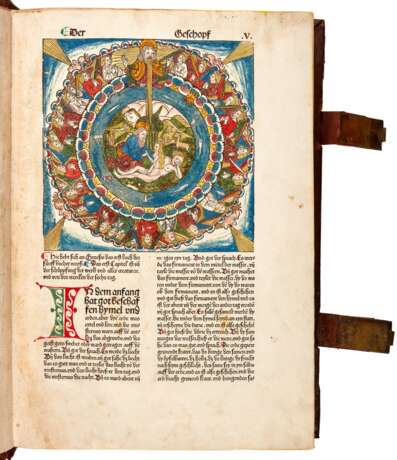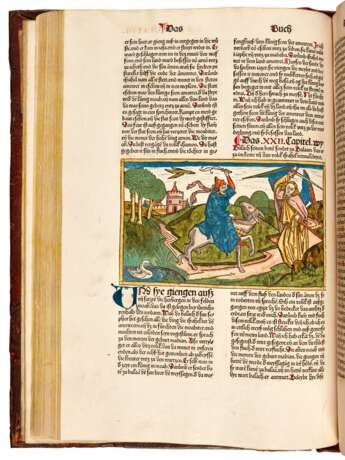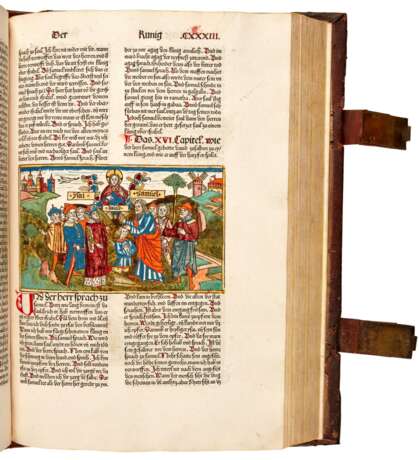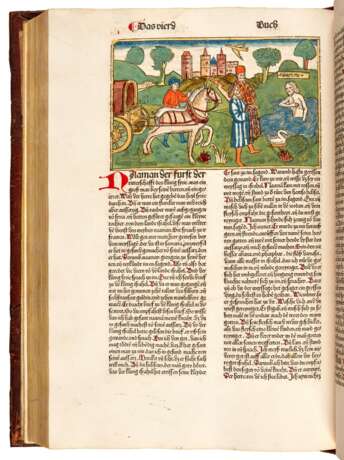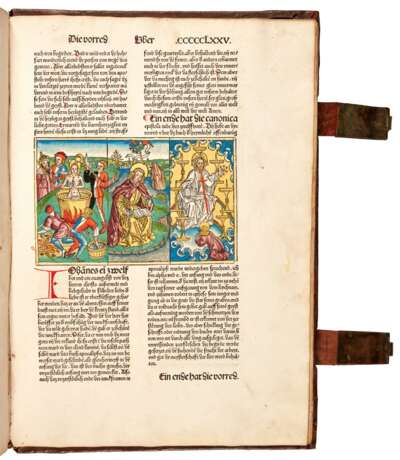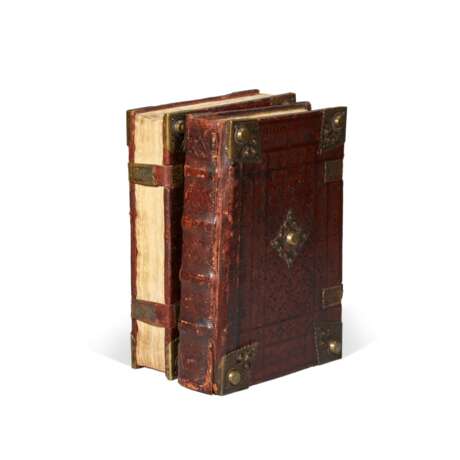ID 1073284
Lot 6 | Bible, German | Nuremberg: Koberger, 1483, contemporary hand-colour and a publisher’s binding
Valeur estimée
£ 40 000 – 60 000
2 volumes, Royal folio (415 x 290mm.), textualy complete, text in double columns, 50 lines, gothic type, red initial strokes, more than 1,000 three-line Lombard initials in red, blue, or green, hundreds of slightly larger initials in red, blue, or green, some with penwork extensions, dozens of six- to eight-line initials in red and blue, some with pink and green penwork infilling, volume 2 opening with two six-line initials in blue or pink with white tracery on a background of delicately etched burnished gold, with acanthus leaf extensions, 109 WOODCUTS BEAUTIFULLY COLOURED BY A CONTEMPORARY HAND, contemporary Nuremberg publisher’s binding by the so-called Schedel Meister, blind-stamped calf over thick wooden boards, upper covers with two frames, the outer one decorated with rosettes connected by leaf-wrapped staffs, the inner one stamped with repeating floral sprig lozenges, enclosing a central panel with blind-tooled vines forming ogival compartments, each of these containing a botanical stamp, both volumes titled in blind at head of outer frame; lower covers with similar outer frame, inner frame with repeating griffin stamp, central panel with either botanical (volume I) or double-headed eagle (volume II) stamps, covers with intricately tooled brass corner- and centrepiece bosses, raised bands, original brass clasps and catches with later leather straps, inner margin of the opening five folios of the first volume expertly renewed without loss of text, the next 60 leaves with expert repair at the bottom of inner margin, occasional faint dampstains, smudges or small stains to margins, thin vertical crack to spine of volume 2, minor crackling or chafing to leather, spine of first volume restored ca. 1900, with newer endleaves
This is a memorable copy of one of the most attractive and important German incunabula, found here in a contemporary binding commissioned by the publisher, the text embellished with many hand-painted initials, and with more than 100 large, striking, and brilliantly hand-coloured woodcuts.
Undoubtedly the most prosperous printer-publisher of the Renaissance, Anton Koberger (1440-1513) is closely associated with the most famous illustrated incunable, the Nuremberg Chronicle of Hartmann Schedel, but his Bibles are equally evocative of the incunabular era. And this ninth German Bible is generally acknowledged as the printer’s second most celebrated and beautiful book. The woodcuts are by the “master of the Cologne Bible” and were clearly influenced by Dürer’s biblical illustrations. In the extraordinary half-page woodcut of the Creation, a circle of approving angels encloses the vast deep of the ocean teeming with sea monsters, within which is the round, verdant island of Eden, from which God gently raises Eve by the hand from the side of sleeping Adam. While this may be the most well-known image in the work, there are many illustrations with great appeal, especially when found, as here, with skilful contemporary colouring.
While Koberger did not have his own bindery, he did employ several Nuremberg bookbinders to cover volumes in a distinctive style' the pleasing bindings here are the work of the Schedel-Meister, so called for the bindings he regularly executed for Koberger’s most famous production. They can be identified by his rosette, griffin, and staff/leaf stamps.
The decorative initials in volumes 1 and 2 are the work of two different artists. Those in the second volume are more graceful and elaborate, and that volume also contains the one illuminated initial.
This set has a distinguished provenance: it was formerly in the Austrian library of Ernst-August, King of Hanover, Duke of Cumberland, and Duke of Brunswick-Lüneburg (1771-1851), and subsequently in the collection of German bibliophile Dr Alexander Schippan (1889-1975).
| Catégorie maison de vente aux enchères: | Impressions, graphiques, livres |
|---|
| Catégorie maison de vente aux enchères: | Impressions, graphiques, livres |
|---|
| Adresse de l'enchère |
Sotheby´s 34-35 New Bond Street W1A 2AA London Royaume-Uni | |
|---|---|---|
| Aperçu |
| |
| Téléphone | +44 (0) 20 7293 5000 | |
| Téléphone | +1 212 606 7000 | |
| Conditions d'utilisation | Conditions d'utilisation |
